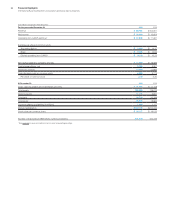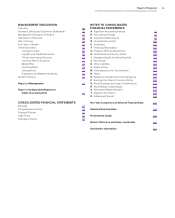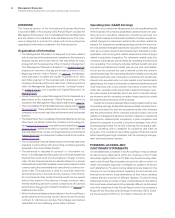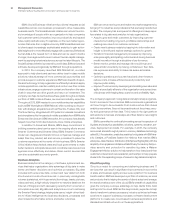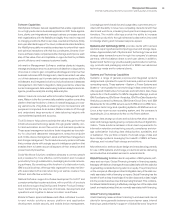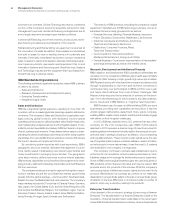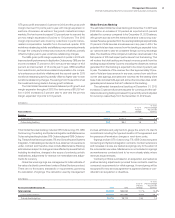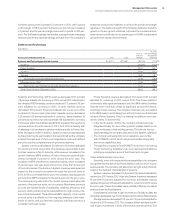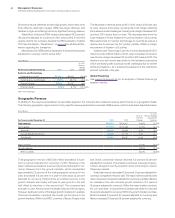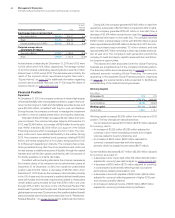IBM 2013 Annual Report Download - page 35
Download and view the complete annual report
Please find page 35 of the 2013 IBM annual report below. You can navigate through the pages in the report by either clicking on the pages listed below, or by using the keyword search tool below to find specific information within the annual report.34 Management Discussion
International Business Machines Corporation and Subsidiary Companies
IBM Research also focuses on differentiating IBM’s services
businesses, providing new capabilities and solutions. It has the
world’s largest mathematics department of any public company,
enabling IBM to create unique analytic solutions and actively engage
with clients on their toughest challenges.
In 2013, IBM was awarded more U.S. patents than any other
company for the 21st consecutive year. IBM’s 6,809 patents
awarded in 2013 represent a diverse range of inventions poised to
enable significant innovations that will position the company to com-
pete and lead in strategic areas such as Watson, cloud computing
and big data analytics. These inventions also will advance the new
era of cognitive systems where machines will learn, reason and inter
-
act with people in more natural ways. It was the most U.S. patents
ever awarded to one company in a single year.
The company continues to actively seek intellectual property
protection for its innovations, while increasing emphasis on other
initiatives designed to leverage its intellectual property leadership.
Some of IBM’s technological breakthroughs are used exclusively in
IBM products, while others are licensed and may be used in IBM
products and/or the products of the licensee. While the company’s
various proprietary intellectual property rights are important to its
success, IBM believes its business as a whole is not materially
dependent on any particular patent or license, or any particular group
of patents or licenses. IBM owns or is licensed under a number of
patents, which vary in duration, relating to its products.
Enterprise Transformation
A key element of the company’s strategy is becoming a Smarter
Enterprise. The transformation to a Smarter Enterprise is built on the
foundation of internal transformation undertaken in the recent past,
where IBM standardized business processes, drove enterprisewide
client service contracts. Global Financing also factors a selected
portion of the company’s accounts receivable, primarily for cash
management purposes. All internal financing arrangements are at
arm’s-length rates and are based upon market conditions.
Commercial Financing: short-term inventory and accounts receiv-
able financing to dealers and remarketers of IT products.
Remanufacturing and Remarketing: as equipment is returned at
the conclusion of a lease transaction, these assets are refurbished
and sold or leased to new or existing clients both externally and
internally. Externally remarketed equipment revenue represents
sales or leases to clients and resellers. Internally remarketed equip-
ment revenue primarily represents used equipment that is sold
internally to Systems and Technology and Global Services. Systems
and Technology may also sell the equipment that it purchases from
Global Financing to external clients.
IBM Worldwide Organizations
The following worldwide organizations play key roles in IBM’s delivery
of value to its clients:
• Sales and Distribution
• Research, Development and Intellectual Property
• Enterprise Transformation
• Integrated Supply Chain
Sales and Distribution
IBM has a significant global presence, operating in more than 175
countries, with an increasingly broad-based geographic distribution
of revenue. The company’s Sales and Distribution organization man-
ages a strong global footprint, with dedicated country-based
operating units focused on delivering client value. Within these units,
client relationship professionals work with integrated teams of con-
sultants, product specialists and delivery fulfillment teams to improve
clients’ business performance. These teams deliver value by under-
standing the clients’ businesses and needs, and then bring together
capabilities from across IBM and an extensive network of Business
Partners to develop and implement solutions.
By combining global expertise with local experience, IBM’s
geographic structure enables dedicated management focus for
local clients, speed in addressing new market opportunities and
timely investments in emerging opportunities. The geographic
units align industry-skilled resources to serve clients’ agendas.
IBM extends capabilities to mid-market client segments by lever-
aging industry skills with marketing, Inside Sales and local Business
Partner resources.
The company continues to invest to capture the long-term oppor-
tunity in markets around the world that have market growth rates
greater than the global average—countries within Southeast Asia,
Eastern Europe, the Middle East and Latin America. The company’s
major markets include the G7 countries of Canada, France, Germany,
Italy, Japan, the United States (U.S.) and the United Kingdom (UK)
plus Austria, the Bahamas, Belgium, the Caribbean region, Cyprus,
Denmark, Finland, Greece, Iceland, Ireland, Israel, Malta, the Nether-
lands, Norway, Portugal, Spain, Sweden and Switzerland.
The majority of IBM’s revenue, excluding the company’s original
equipment manufacturer (OEM) technology business, occurs in
industries that are broadly grouped into six sectors:
• Financial Services: Banking, Financial Markets, Insurance
• Public: Education, Government, Healthcare, Life Sciences
• Industrial: Aerospace and Defense, Automotive,
Chemical and Petroleum, Electronics
• Distribution: Consumer Products, Retail,
Travel and Trans portation
• Communications: Telecommunications,
Media and Entertain ment, Energy and Utilities
• General Business: Cross-sector representation of intermediate-
sized large enterprises as well as mid-market clients
Research, Development and Intellectual Property
IBM’s research and development (R&D) operations differentiate the
company from its competitors. IBM annually invests approximately
$6 billion for R&D, focusing on high-growth, high-value opportunities.
IBM Research works with clients and the company’s business units
through 12 global labs on near-term and mid-term innovations. It
contributes many new technologies to IBM’s portfolio every year
and helps clients address their most difficult challenges. IBM
Research also explores the boundaries of science and technol-
ogy—from nanotechnology to future systems, big data analytics,
secure clouds and to IBM Watson, a ‘‘cognitive’’ learning system.


